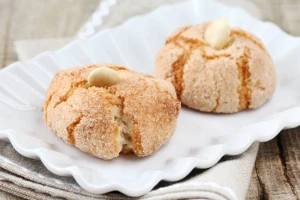Almond Macaroons

These Almond Macaroons are simple and delicious, perfect for dessert or as a snack. Made with blanched almonds and powdered sugar for a sweet touch. The almond extract gives them a unique flavor that's sure to be a hit at your next meal.
Macaroons are a traditional style of cookie that uses a mixture of almonds, sugar, and egg whites. This recipe uses blanched almonds to make delicious homemade macaroons.

Ingredients
145 grams blanched almonds 145 grams powdered sugar 1½ tsp almond extract pinch of salt 2 egg whites
Method
- 1. Preheat the oven to 200 °C. Place a few sheets of an old newspaper on the baking tray and then put a sheet of baking paper on it. The newspaper ensures that the bottom of the macaroons does not get too dark. Mix the almonds with the powdered sugar in a food processor very fine.
- 2. Add the almond extract, salt, and egg whites and mix everything into a creamy paste. Put the paste in a piping bag with a smooth nozzle of 1 centimeter.
- 3. Use it to pipe caps with a diameter of 3 centimeters on the baking paper. Alternatively, use two spoons to place small scoops of dough. Any protruding points can be flattened with a wet finger.
- 4. Bake the macaroons for 12-17 minutes until they are a light golden brown. Slide the sheet of baking paper immediately after baking onto a wet tea towel so that the cookies come off easier.

The Art of Baking Macaroons
Macaroon baking is an art that dates back centuries. The sweet flavor and chewy texture of macaroons come from the process of mixing almonds, sugar, and egg whites. This recipe uses blanched almonds to make delicious homemade macaroons.
Almond Macaroons, as a broad category of confections, have a rich history that spans across many countries and centuries. The word "macaroon" comes from the Italian "maccarone" or "maccherone" meaning "paste", referring to the original almond paste used in the recipe. The macaroon, as we know it, likely originated in Italy, specifically from an Italian monastery. The recipe then traveled to France in 1533 with the pastry chefs of Catherine de Medici, a noblewoman from Florence who married the future King Henry II of France.
As the macaroon recipe traveled across Europe, different countries adapted it to their own tastes and local ingredients. In the Netherlands, this adaptation is known as "bitterkoekjes". Bitterkoekjes, or "bitter cookies", are a type of macaroon that is particularly popular in Dutch cuisine. They are similar to the Italian amaretti but have a distinctive flavor and texture.
Bitterkoekjes are traditionally made with bitter almonds, which give them their characteristic flavor. Bitter almonds contain a small amount of prussic acid (also known as hydrogen cyanide) which can be lethal in large doses but is broken down during the baking process, leaving behind a distinctive bitter flavor. Today, due to the potential health risks associated with bitter almonds, Granny prefers to substitute them with sweet almonds and add almond extract to achieve the desired flavor.
These cookies are typically small, round, and have a crunchy exterior with a soft, chewy interior. They are often enjoyed with a cup of coffee or tea. Bitterkoekjes are also used in some Dutch desserts, such as in puddings or crushed as a base for cheesecakes.
The history of bitterkoekjes is a testament to the adaptability and versatility of the original macaroon recipe. From Italy to France, and then to the Netherlands, each culture has put its own spin on this classic cookie, resulting in a wide variety of delicious treats enjoyed around the world.
Serving suggestions for macaroons are as varied as the meals they accompany. Here are a few ideas:
- With Tea or Coffee: A classic choice. Macaroons served with your favorite tea or coffee can be a simple yet satisfying treat.
- With Ice Cream: Macaroons can be used as a garnish for your favorite ice cream, adding a crunchy texture.
- As a Gift: Packaged in a beautiful box, macaroons can make a wonderful gift for friends and family.
This recipe for Almond Macaroons brings the art of macaroon baking into your kitchen. Remember, the beauty of macaroons lies in their simplicity and versatility. They're perfect for dessert or as a snack, and the almond extract gives them a unique flavor that's sure to be a hit at your next meal.